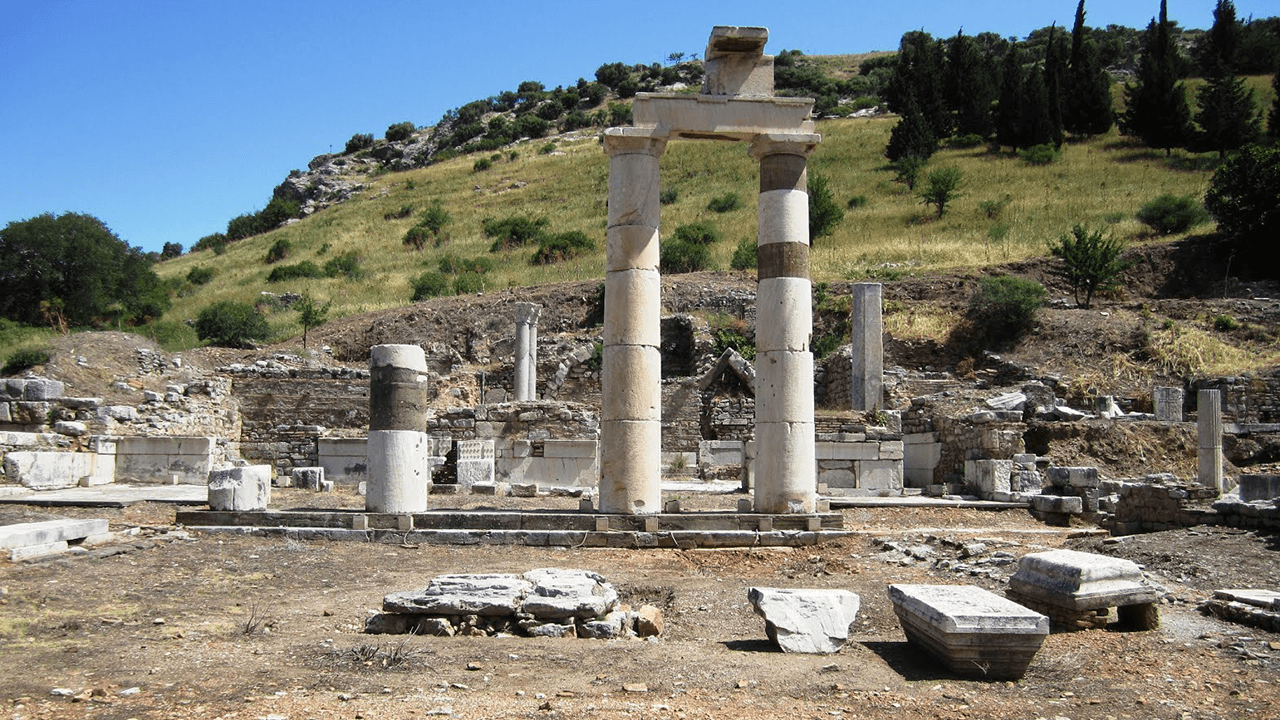The Prytaneion: The Ceremonial Heart of Ephesus
Located behind the Basilica of Ephesus, the Prytaneion served as the ceremonial and administrative center of the city. It hosted religious ceremonies, official receptions, and banquets, solidifying its role as a vital hub in the public life of Ephesus. The sacred flame, symbolizing the heart of the city, was kept perpetually alight here, reinforcing its significance as a spiritual center.
History and Origin of the Prytaneion
The construction of the Prytaneion dates back to the 3rd century BCE, during the reign of Lysimachus, although the ruins visible today belong to the Augustan period. This site played a central role in the religious and social life of Ephesus, representing the connection between the divine and the earthly in the city’s culture.
The Importance of the Sacred Flame
The sacred flame, kept constantly burning, symbolized the spirit and vitality of Ephesus. This eternal fire represented the continuity of the city and its connection to the gods, serving as a central element in the ceremonies conducted at the Prytaneion.
Design and Architecture of the Prytaneion
The Prytaneion was designed with an architectural style befitting its ceremonial importance. The building’s facade featured four columns leading to a courtyard surrounded by a colonnade. At the center of the building, towards the north, was the ceremonial hall flanked by side rooms. This architectural arrangement allowed for ceremonies and meetings in a dignified and solemn setting.
The Ceremonial Hall
The floor of the ceremonial hall was marked with a distinctive red hue, indicating the location of the eternal flame. This architectural detail not only added a visual element to the building but also reinforced its symbolism as a sacred space.
The Altar and Rear Area
Behind the ceremonial hall was a spacious area with a wooden roof, where the base of an altar was located. This space, used for additional ceremonies and rituals, extended the religious purpose of the Prytaneion.
Archaeological Discoveries
During excavations at the Prytaneion, archaeologists uncovered two statues of Artemis, the patron goddess of Ephesus. These statues, now displayed in the Ephesus Museum, testify to the central role of this site in the city’s religious life and its dedication to the goddess.
A Link to the Devotion to Artemis
The presence of Artemis statues in the Prytaneion highlights the importance of this goddess in Ephesian culture. Their inclusion in this ceremonial space emphasizes the connection between the Prytaneion and the cult of Artemis, showcasing the relationship between civic administration and religion.
Cultural Significance of the Prytaneion
The Prytaneion was not only a ceremonial center but also a symbol of unity and identity for Ephesus. This site strengthened the bond between the citizens and their rulers, serving as a space where key events reinforced the sense of community and belonging.
A Space of Unity
The Prytaneion was more than just a building; it was the heart of Ephesus, where the city’s traditions and values were manifested through significant ceremonies and events.
Tips for Visiting the Prytaneion
- Location: Situated behind the Basilica of Ephesus within the archaeological complex of the city.
- Recommended Time to Visit: Visit early in the morning or at sunset to enjoy a quieter experience and observe architectural details under soft lighting.
- Respect the Site: As an archaeological site, avoid touching the structures or interfering with restricted areas to help preserve this valuable heritage.
Conclusion
The Prytaneion of Ephesus encapsulates the spiritual and cultural essence of this ancient city. From the sacred flame to the statues of Artemis, every element of this building reflects the importance of ceremonies and traditions in the lives of the Ephesians. Visiting the Prytaneion is a unique experience to delve into the history of Ephesus and understand its significance as a ceremonial and administrative center. This monument remains a vibrant testimony to the splendor and devotion of one of the most influential cities of the ancient world.


3 thoughts on “The Prytaneion”
★★★★★
I was blown away by everything ‘The Prytaneion’ has to offer. Definitely a place to return to in the future.
★★★★★
Learning about and visiting ‘The Prytaneion’ was both fun and educational. Everyone should experience this!
★★★★★
Exploring ‘The Prytaneion’ exceeded all my expectations. A perfect combination of culture, beauty, and knowledge.